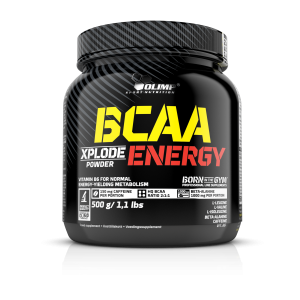Modern 'bulks' – a breakthrough in building muscle mass

Carbohydrate-protein (CP) supplements, still remain the most popular products serving as aid in a rapid increase of body weight for those working out at the gym. The first one of this type of supplements in Poland was Olimp Gainer® (1), and from this brand name supplements of similar composition modelled on this product started to be popularly called “gainers”. Previously, weight gain was not necessarily synonymous with an increase in muscle mass – more often than not supplementation had led to enlargement of “pot belly” circumference and generalised body fatness. This unfavourable state of affairs stemmed directly from the fact that the carbohydrate-protein products, just a few years ago, were not particularly sophisticated and complex in terms of their composition and quality of components used in their production. The supplements for muscle growth, produced worldwide, had their origins in dietary products for infants, eaten in large quantities by bodybuilders as a panacea for the stagnation in the development of muscle mass. With time, dedicated products, already specifically for athletes, started to appear – usually based on one source of carbohydrates, most commonly simple sugar though sometimes with a slight admixture of starch, as well as on a single source of protein, often casein (only later whey protein started to be used). Those looking for cheaper solutions opted for ordinary whey the nutritional parameters of which, for bodybuilders, were even worse. Nutrients like Olimp Gainer®, by weight, consisted of about 15-20% protein, while carbohydrates, largely simple sugars, constituted the remainder, while fat content was 5 g per 100 g of the product. Popular were also the so-called “bulks” having the protein-to-carbohydrate ratio of approx. 1:1, with the protein content of about 40 g/100 g. Of course, there were available on the market all versions in between the conventional “gainer” supplements and the “bulks”, however the individual ingredients usually remained the same. These products were a response of manufacturers to builders’ demands at that time (in line with prevailing knowledge about nutrition in this discipline), who in periods between competitions would significantly (and quickly) increase their body weight, only to later reduce as much fat as possible while trying to retain a maximum of muscle mass. This practice was extremely hard on the body in terms of health, which was often reflected in the quality of muscle mass and, consequently, the place on the podium. Currently, the approach to this issue visibly changes. Bodybuilders try to develop their muscles and shape their body in a slower and more stable manner, so that while working on their muscle definition they have as little body fat to lose as possible – which translates into a smaller decrease in muscle mass itself and provides for its definitely better quality. Thus, the market must respond to very reasonable and pro-health demands from the consumers.
At present, the most renowned manufacturers focus their activities very effectively on the development of multi-component CP supplements of excellent quality, “bulks” and all intermediate products, based on carbohydrates with low glycemic index (GI). Only now these supplements are not to, literally, fatten up, but to very efficiently assist in building lean body mass. This is achieved by using selected components. As already mentioned, these are carbohydrates with low glycemic index, such as poly-and oligosaccharides, long-chain waxy maize starch or isomaltulose, used in various combinations or sometimes all together. Some of these compounds have only recently started to be used in the development of dietary supplements – for instance isomaltulose (palatinose), a naturally occurring disaccharide made of glucose and fructose, not used previously in the production of low-glycemic foodstuff and drinks. Conducted studies (2) show that this compound is fully degraded and absorbed in the small intestine, as well as completely safe in use. It is not harmful to the developing foetus (no embryotoxicity or teratogenicity), while exerts a positive effect on the body of a sportsperson caring about the development or maintaining of muscle mass. Administration of isomaltulose at 50 g results in a much slower rise in blood glucose and insulin levels – and effect persisting for about 3 hours (3). What is more, it has been shown (3) that isomaltulose lowers the efficiency of glucose absorption from the small intestine, thus contributing to the maintenance, to some extent, of stable blood sugar levels and a reduction in the risk of excessive body fat stemming from high blood glucose. The taking of isomaltulose for 4 weeks led to a significant improvement in insulin receptor sensitivity and lowered blood sugar (4), thus outlining an additional, pro-health property of this nutrient. A compound exhibiting similar activity on the human body to isomaltulose is the long chain waxy maize starch, although here the level of glucose and, consequently, insulin is even lower as compared with palatinose, and remains stable for more than 4 hours from administration (5), which means that it may fully meet its role in CP supplements when taken before bedtime, or as a substitute of or complement to a meal. The above studies also show that waxy maize, better than other sources of carbohydrates (e.g. maltodextrin), suppresses hunger and provides a fuller feeling of satiety, which translates directly into maintaining the regularity of meals, significantly reducing the desire, in some people, for in between-meal snacking.
The modern CP supplements currently being developed do not involve just the use of low glycemic sources of carbohydrates, but also the components without which the former could not act effectively – the proteins. The top-quality CP supplements available on the Polish market, modelled on Gainer®, “bulk” products and all their intermediates contain several high-quality protein sources. Typically, these include whey protein concentrate, but in addition it may be the isolate and hydrolysate of these proteins, as well as chicken egg protein, or micellar casein, highly desirable in this class of nutrients. The aim of such a complex protein mixture is ensuring continuous blood saturation with amino acids necessary for building a powerful and lasting muscle definition. It is also worthy to reinforce the composition of the product with compounds exhibiting an additional anti-catabolic effect: L-glutamine, branched-chain amino acids (BCAA), as well as those having a purely anabolic activity, such as creatine in its various forms. The use in modern CP supplements of all the above protein sources, as well as additional ingredients, ensures constant supply of muscle cells with amino acids essential in the processes of muscle tissue regeneration and building.
It is an undisputable fact that any self-respecting company operating in the sports supplementation field must have in its offer a full range of carbohydrate-protein supplements based on the abovementioned ingredients. Consumers should not be forced to choose between the CP composition typical for Gainer® or “bulk”, or have available only one type of a supplement, argued to be the best one for the development of muscle mass. It is necessary to provide an athlete with an option of choosing a product that will be in perfect harmony with their dietary regimen – one that is based on just the right (for them) ratio of carbohydrates to protein. Fortunately, we have on the Polish market domestic companies that approach the subject of sports supplementation very seriously, have their own laboratories, and offer a wide range of carbohydrate-protein supplements that are consistent, in terms of quality, with the highest world standards and dietary trends.
Piotr Kaczka, PhD Eng
Bibliography:
(1) http://www.uprp.pl/patentwebaccess/PatentDetails.aspx
(2) Lina BA, Jonker D, Kozianowski G. Isomaltulose (Palatinose): a review of biological and toxicological studies. Food Chem Toxicol. 2002 Oct;40(10):1375-81.
(3) Kashimura J, Nagai Y. Inhibitory effect of palatinose on glucose absorption in everted rat gut. J Nutr Sci Vitaminol (Tokyo). 2007 Feb;53(1):87-9.
(4) Holub I, Gostner A, Theis S, Nosek L, Kudlich T, Melcher R, Scheppach W. Novel findings on the metabolic effects of the low glycaemic carbohydrate isomaltulose (Palatinose). Br J Nutr. 2010 Mar 9:1-8.
(5) Sands AL, Leidy HJ, Hamaker BR, Maguire P, Campbell WW. Consumption of the slow-digesting waxy maize starch leads to blunted plasma glucose and insulin response but does not influence energy expenditure or appetite in humans. Nutrition Research 29 (2009) 383–390
BACK ›

